If you are able to see the world without any issue, you should consider yourself lucky as many people in the world do not have the ability to see the world clearly due to many conditions affecting the eye. Eye health is often taken for granted unless a person is already affected by the symptoms such as blurred vision or discomfort and pain of the eyes. Health services such as scleral buckles are certainly needed in some cases of sudden impaired eye vision. Here we will learn a bit more on scleral buckles.
To understand scleral buckle, it is best to understand more on the condition needing the procedure known as retinal detachment. Retinal detachment is an eye problem that occurs when the retina is pulled away from the original position at the back of the eye. The retina itself is the thin layer of tissue that functions in capturing the light entering the eyes and helps in translating light into images that we can see. Thus, in retinal detachment, the detached retina is unable to work properly in eye vision, causing blurry vision to the extent of blindness. Retinal detachment is considered as an emergency as it is a serious eye problem. Symptoms may not be obvious if only small part of the retina are affected but as more retina is detached, symptoms such as inability to see normally, flashes of light, seeing new floaters (small dark spot or squiggly lines floating across the vision) and dark shadow or curtain on the side or middle field of eye vision.
Scleral buckle is a one of the surgery performed to treat retinal detachments. It is a surgery that places permanent silicone band around the eyes to help retain the retinal layer in place. Just as the name implies, it wraps around the eyeball like a belt or buckles. It is one of the favourable surgery to be done on retinal detachment cases as there is few complications and little to none needs for post-operative positioning. Due to the fact that it can be small to none postoperative positioning is needed, some patients might wonder how long will a scleral buckle last. One thing for sure, this scleral buckle remain around the eye permanently. This means that that scleral buckle can last for a lifetime. It is worth noting that in small cases, scleral buckle may need to be removed or if there is evidence of infection.
Scleral buckle helps to reattach retina in up to 90% patients. Typically this surgery is performed in the operating theatres. Scleral buckle surgery may be combined with other procedures such as vitrectomy. Vitrectomy is a procedure of removing the vitreous jelly inside the eyes through small cuts on the sclera. This can help the retina return into its normal initial position. Some cases may require injection of a gas bubble to help the retina be in its proper location after vitrectomy. Another procedure that may be done along with scleral buckle is cryotherapy. Cryotherapy uses freezing elements to induce retinal scar around the tear of which the scar acts as glue to aid in retinal reattaches. It is common for antibiotic drops to be used into the eyes to prevent infection. Eye patches are placed over the eyes to help patients feel comfort.
Patient often are allowed to return home on the same day after the procedure is done. Some discomfort is considered normal for few days following the surgery but prolonged discomfort should raise concern and need medical advice. Some swelling, tenderness and redness is also expected for few weeks after surgery. Recovery for scleral buckle procedure may take up to 4 weeks. Patients need to follow all advice or instructions given by doctors such as using eye drops as prescribed to prevent infection and ease inflammation. Wearing eye patch can protect the eyes from insults. It is vital for patient to attend all follow-up as scheduled to ensure recovery process is ongoing and the eyes are properly heal.
Similar to many other procedures or surgery, scleral buckles do come with possible complications or risk. Common complication is the retinal redetachment which may be as high as 47% in the first year. Other complications include perforated eyeballs, bleeding in the eyes, infection, trauma to the cornea (clear front part of the eyes), increased pressure inside the eyes (intraocular pressure), increased near-sightedness and eye muscle damage. It is best to ensure that patients understand that the risk and complications will always be around in any surgery but this can be minimised to zero when it is done by a good and experienced surgeon.
It can be concluded that scleral buckle is one of the common procedures used to treat retinal detachment. Retinal detachment is a condition where the thin layer of retina is pulled away from the back of the eyes. It is a condition that causes blurred vision or even blindness that is usually not associated with pain.








